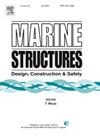Deterministic real-time prediction of ship roll motion with quantified uncertainty based on machine learning
IF 5.1
2区 工程技术
Q1 ENGINEERING, CIVIL
引用次数: 0
Abstract
Real-time prediction of the ship motion in advance can effectively enhance the safety and efficiency of maritime operations. However, the current prediction methods mainly focus on the motion time series forecasting without considering the uncertainty existing in measured motions. In this paper, a novel prediction method combined with the confidence interval forecasting of the motion is proposed. The method integrates the probability prediction module into the time-series prediction model. The normal distribution and student’s T-distribution are considered and the long short-term memory (LSTM) neural network is selected as the time-series prediction model. A set of measured full-scale ship roll motion of Yukun Ship is used to verify the prediction performance. The results demonstrate that the proposed method can effectively predict the confidence intervals of future ship motions, especially for extreme motions. This approach circumvents the issue of reduced accuracy over longer prediction periods, which is commonly existed in traditional time-series prediction models due to the influence of non-stationary characteristics of the data. Particularly, at the confidence level of 99 %, the prediction results could cover >90 % of the motion time series for future 12 s, which can significantly ensure the safety of offshore operations.
基于机器学习的船舶横摇运动量化不确定性的确定性实时预测
提前对船舶运动进行实时预测,可以有效地提高海上作业的安全性和效率。然而,目前的预测方法主要集中在运动时间序列的预测上,没有考虑到实测运动中存在的不确定性。本文提出了一种结合运动置信区间预测的预测方法。该方法将概率预测模块集成到时间序列预测模型中。考虑正态分布和学生t分布,选择长短期记忆神经网络作为时间序列预测模型。利用玉昆舰的一组实测全尺寸船舶横摇运动来验证预测的性能。结果表明,该方法可以有效地预测船舶未来运动的置信区间,特别是对极端运动的置信区间。这种方法避免了由于数据的非平稳特征的影响,传统时间序列预测模型中普遍存在的较长预测周期内精度降低的问题。特别是,在99%的置信水平下,预测结果可以覆盖未来12 s运动时间序列的90%,这可以大大确保海上作业的安全性。
本文章由计算机程序翻译,如有差异,请以英文原文为准。
求助全文
约1分钟内获得全文
求助全文
来源期刊

Marine Structures
工程技术-工程:海洋
CiteScore
8.70
自引率
7.70%
发文量
157
审稿时长
6.4 months
期刊介绍:
This journal aims to provide a medium for presentation and discussion of the latest developments in research, design, fabrication and in-service experience relating to marine structures, i.e., all structures of steel, concrete, light alloy or composite construction having an interface with the sea, including ships, fixed and mobile offshore platforms, submarine and submersibles, pipelines, subsea systems for shallow and deep ocean operations and coastal structures such as piers.
 求助内容:
求助内容: 应助结果提醒方式:
应助结果提醒方式:


